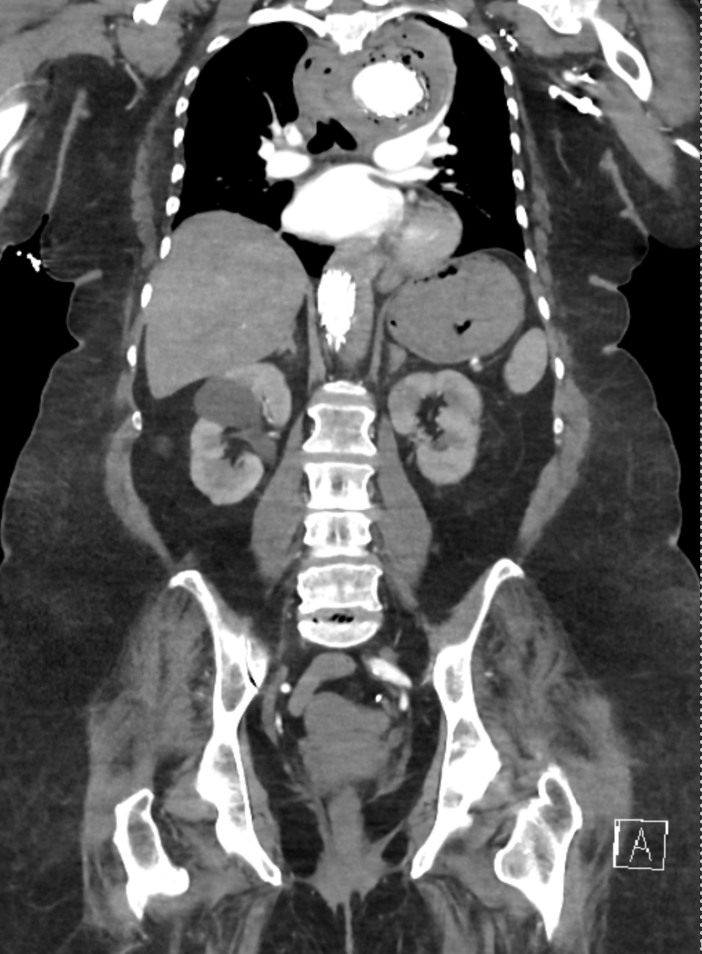Tuesday Poster Session
Category: GI Bleeding
P5226 - Aorto-esophageal Fistula as a Rare Cause of Upper Gastrointestinal Bleeding
Tuesday, October 28, 2025
10:30 AM - 4:00 PM PDT
Location: Exhibit Hall

Mark McGarrey, MD (he/him/his)
Lankenau Medical Center
Wynnewood, PA
Presenting Author(s)
Mark McGarrey, MD, Lauren Davis, DO, Erin Hollis, DO, Nicole Albert, DO, Andrew Krane, MD
Lankenau Medical Center, Wynnewood, PA
Introduction: Upper gastrointestinal (GI) bleeding is a significant cause of morbidity and mortality in hospitalized patients, with a broad differential diagnosis. While common etiologies include peptic ulcer disease and varices, rare causes such as aorto-esophageal fistula (AEF) must be considered, especially given their high mortality. AEF, often presenting with massive bleeding, requires a high index of suspicion for timely diagnosis and intervention. We present a 77-year-old female with upper GI bleeding secondary to AEF in the setting of an infected thoracic aortic endograft.
Case Description/
Methods: A 77-year-old female with a remote history of Type A aortic dissection status post thoracic aortic endovascular repair presented with fever, chills, and melena. Labs revealed a hemoglobin of 5.4 g/dL. CT chest showed a gas-containing abscess in the medial aortic hemiarch and extraluminal contrast concerning for endoleak. Given her comorbidities, she was deemed to be a poor surgical candidate and was started on broad-spectrum antibiotics for presumed graft infection. Initial upper endoscopy showed normal esophageal mucosa and inflamed, ulcerated gastric mucosa without active bleeding. On hospital day six, she developed new-onset atrial fibrillation and was started on intravenous heparin. Hours later, she experienced massive hematemesis. Repeat endoscopy revealed active bleeding in the upper esophagus with a large submucosal hematoma and overlying clot, consistent with an aorto-esophageal fistula likely due to erosion from a mycotic aneurysm. Given ongoing bleeding and poor prognosis, goals of care were transitioned to comfort-focused measures.
Discussion: Aorto-esophageal fistula (AEF) is an exceptionally rare but life-threatening cause of upper gastrointestinal bleeding, accounting for less than 0.1% of all cases. It is most associated with thoracic aortic aneurysms, malignancy, trauma, or complications from thoracic endovascular aortic repair. Clinical presentations are often nonspecific, typically including hematemesis, fever, and epigastric pain. This can lead to frequent delays in diagnosis. CT angiography is the imaging modality of choice, while endoscopy aids in excluding other etiologies and guiding management. Despite advances in endovascular techniques, AEF carries an estimated mortality rate of 60-90%, even with intervention. Given its rarity but high mortality, clinicians must maintain a high index of suspicion in the appropriate clinical context to enable timely recognition and improve outcomes.

Figure: Coronal computed tomography angiography demonstrating extensive soft tissue thickening surrounding the aortic arch with associated intramural and extraluminal gas, findings highly suggestive of an infected thoracic aortic endograft with mycotic aneurysm.

Figure: (1A) Active arterial bleeding in the upper esophagus. (1B-C) Large submucosal hematoma in the upper third of the esophagus with surrounding mucosal disruption. These findings are consistent with an aorto-esophageal fistula, likely secondary to erosion from an infected thoracic aortic endograft.
Disclosures:
Mark McGarrey indicated no relevant financial relationships.
Lauren Davis indicated no relevant financial relationships.
Erin Hollis indicated no relevant financial relationships.
Nicole Albert indicated no relevant financial relationships.
Andrew Krane indicated no relevant financial relationships.
Mark McGarrey, MD, Lauren Davis, DO, Erin Hollis, DO, Nicole Albert, DO, Andrew Krane, MD. P5226 - Aorto-esophageal Fistula as a Rare Cause of Upper Gastrointestinal Bleeding, ACG 2025 Annual Scientific Meeting Abstracts. Phoenix, AZ: American College of Gastroenterology.
Lankenau Medical Center, Wynnewood, PA
Introduction: Upper gastrointestinal (GI) bleeding is a significant cause of morbidity and mortality in hospitalized patients, with a broad differential diagnosis. While common etiologies include peptic ulcer disease and varices, rare causes such as aorto-esophageal fistula (AEF) must be considered, especially given their high mortality. AEF, often presenting with massive bleeding, requires a high index of suspicion for timely diagnosis and intervention. We present a 77-year-old female with upper GI bleeding secondary to AEF in the setting of an infected thoracic aortic endograft.
Case Description/
Methods: A 77-year-old female with a remote history of Type A aortic dissection status post thoracic aortic endovascular repair presented with fever, chills, and melena. Labs revealed a hemoglobin of 5.4 g/dL. CT chest showed a gas-containing abscess in the medial aortic hemiarch and extraluminal contrast concerning for endoleak. Given her comorbidities, she was deemed to be a poor surgical candidate and was started on broad-spectrum antibiotics for presumed graft infection. Initial upper endoscopy showed normal esophageal mucosa and inflamed, ulcerated gastric mucosa without active bleeding. On hospital day six, she developed new-onset atrial fibrillation and was started on intravenous heparin. Hours later, she experienced massive hematemesis. Repeat endoscopy revealed active bleeding in the upper esophagus with a large submucosal hematoma and overlying clot, consistent with an aorto-esophageal fistula likely due to erosion from a mycotic aneurysm. Given ongoing bleeding and poor prognosis, goals of care were transitioned to comfort-focused measures.
Discussion: Aorto-esophageal fistula (AEF) is an exceptionally rare but life-threatening cause of upper gastrointestinal bleeding, accounting for less than 0.1% of all cases. It is most associated with thoracic aortic aneurysms, malignancy, trauma, or complications from thoracic endovascular aortic repair. Clinical presentations are often nonspecific, typically including hematemesis, fever, and epigastric pain. This can lead to frequent delays in diagnosis. CT angiography is the imaging modality of choice, while endoscopy aids in excluding other etiologies and guiding management. Despite advances in endovascular techniques, AEF carries an estimated mortality rate of 60-90%, even with intervention. Given its rarity but high mortality, clinicians must maintain a high index of suspicion in the appropriate clinical context to enable timely recognition and improve outcomes.

Figure: Coronal computed tomography angiography demonstrating extensive soft tissue thickening surrounding the aortic arch with associated intramural and extraluminal gas, findings highly suggestive of an infected thoracic aortic endograft with mycotic aneurysm.

Figure: (1A) Active arterial bleeding in the upper esophagus. (1B-C) Large submucosal hematoma in the upper third of the esophagus with surrounding mucosal disruption. These findings are consistent with an aorto-esophageal fistula, likely secondary to erosion from an infected thoracic aortic endograft.
Disclosures:
Mark McGarrey indicated no relevant financial relationships.
Lauren Davis indicated no relevant financial relationships.
Erin Hollis indicated no relevant financial relationships.
Nicole Albert indicated no relevant financial relationships.
Andrew Krane indicated no relevant financial relationships.
Mark McGarrey, MD, Lauren Davis, DO, Erin Hollis, DO, Nicole Albert, DO, Andrew Krane, MD. P5226 - Aorto-esophageal Fistula as a Rare Cause of Upper Gastrointestinal Bleeding, ACG 2025 Annual Scientific Meeting Abstracts. Phoenix, AZ: American College of Gastroenterology.

